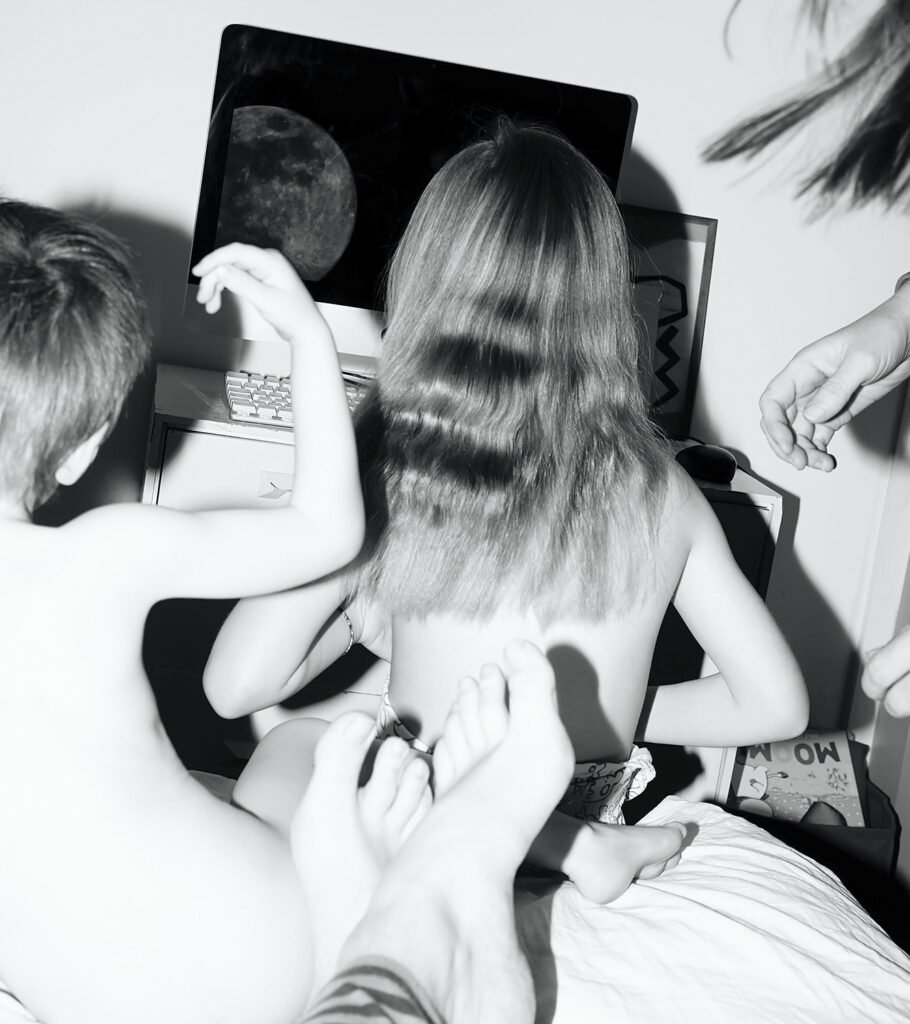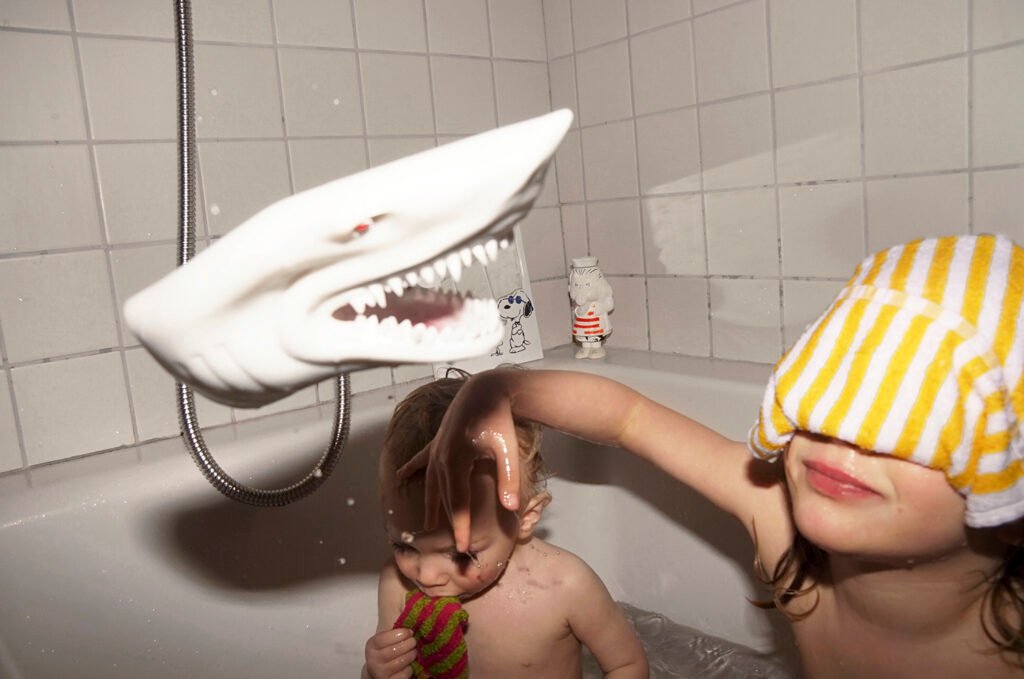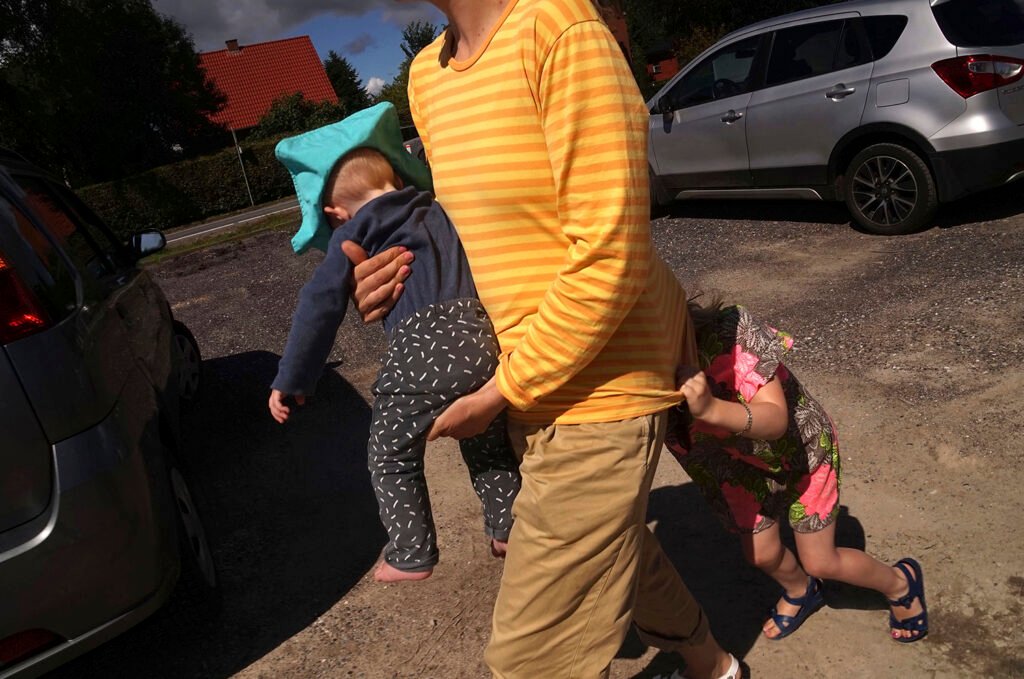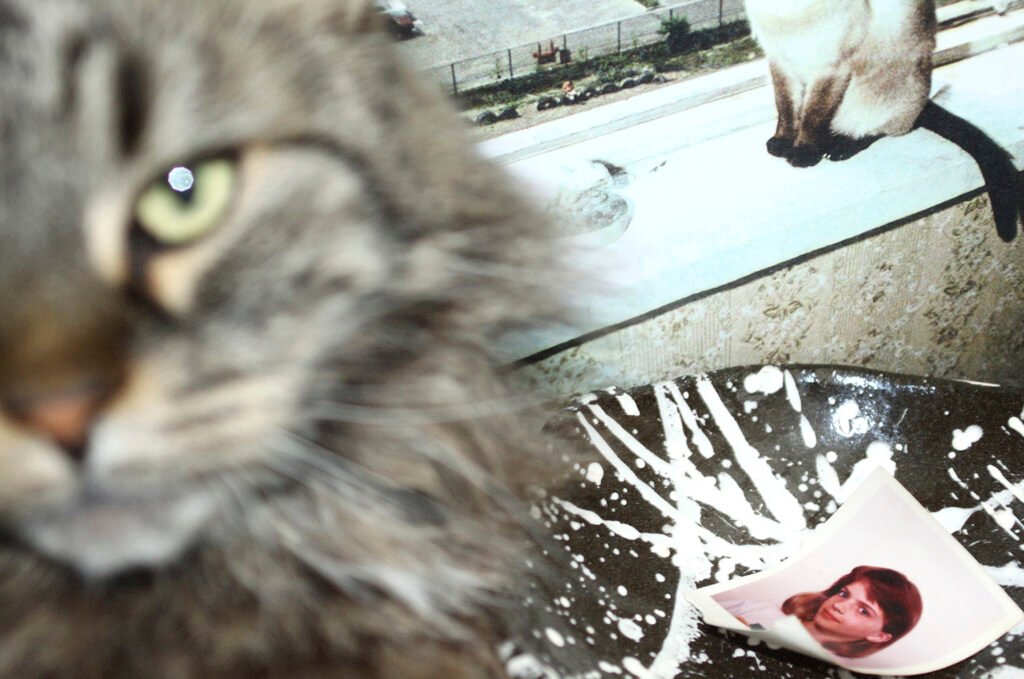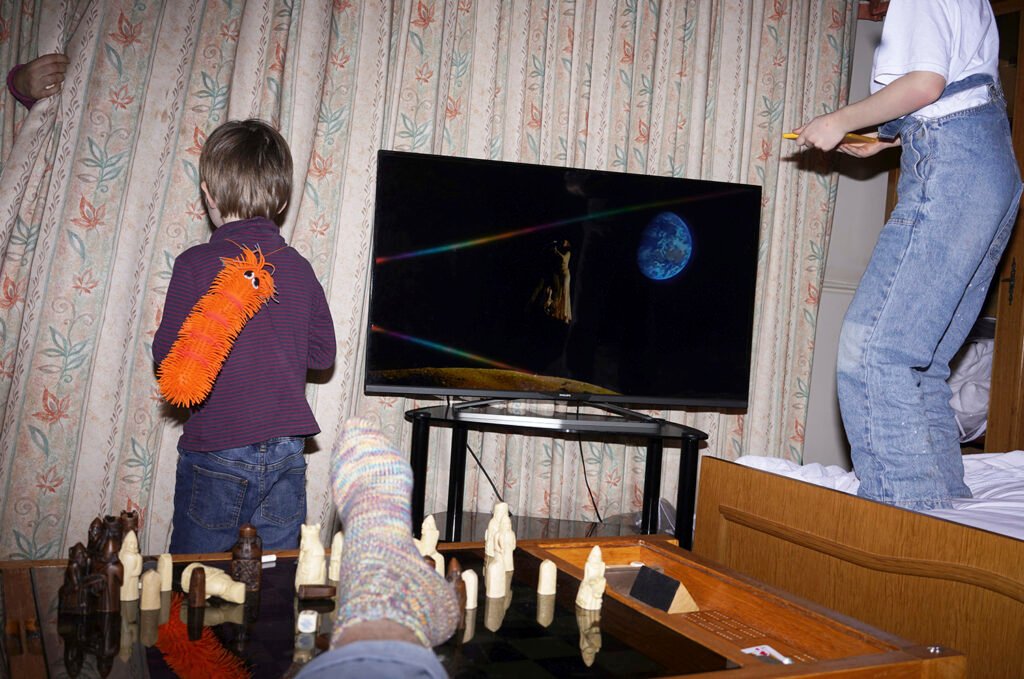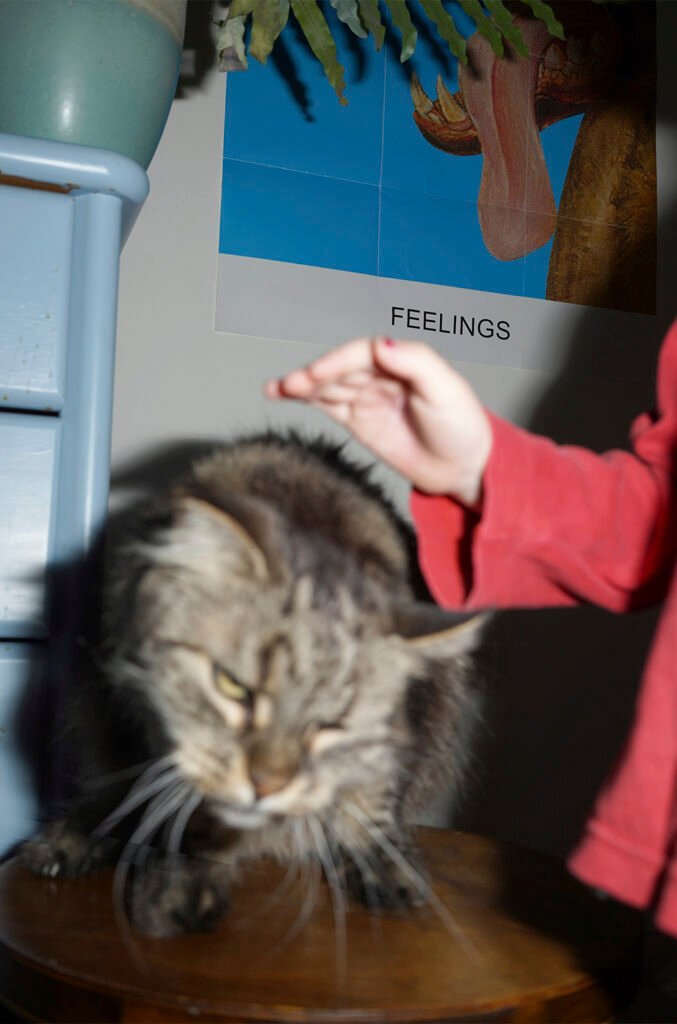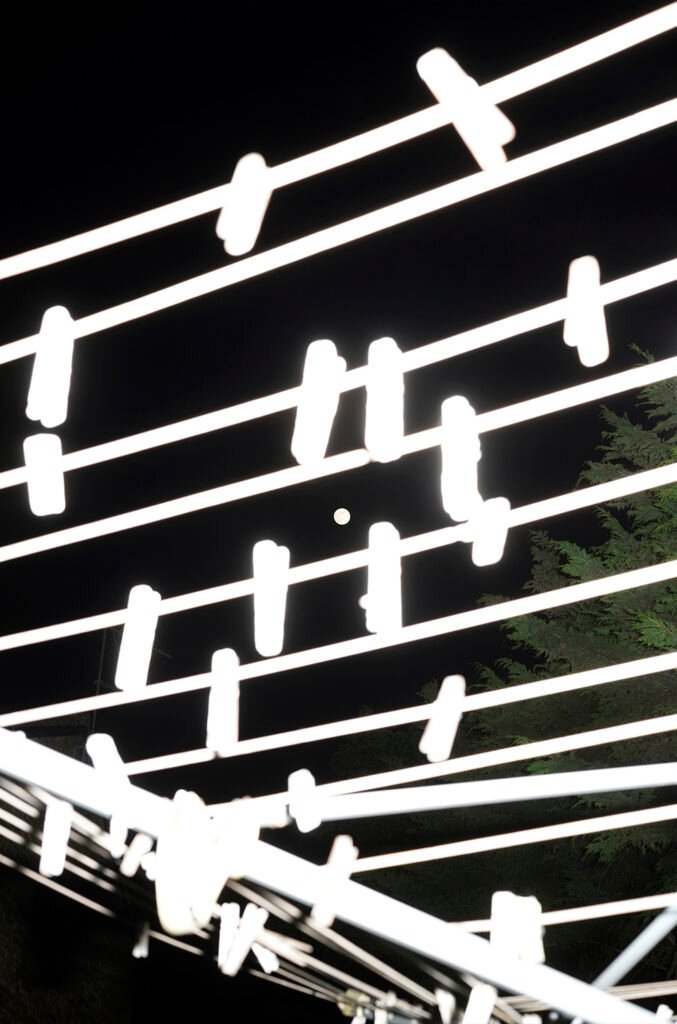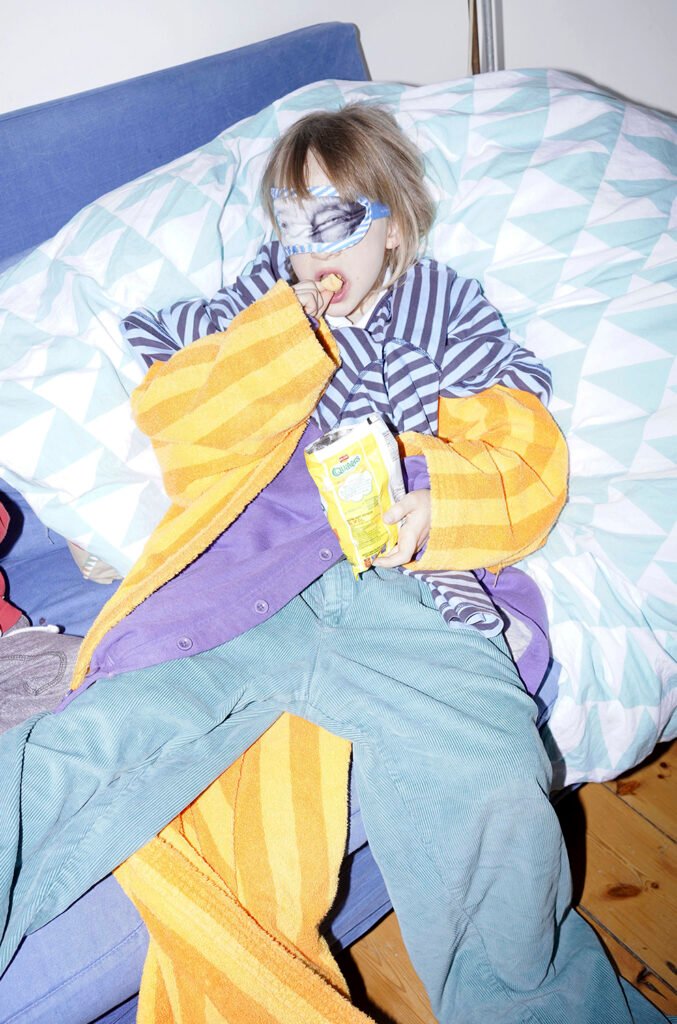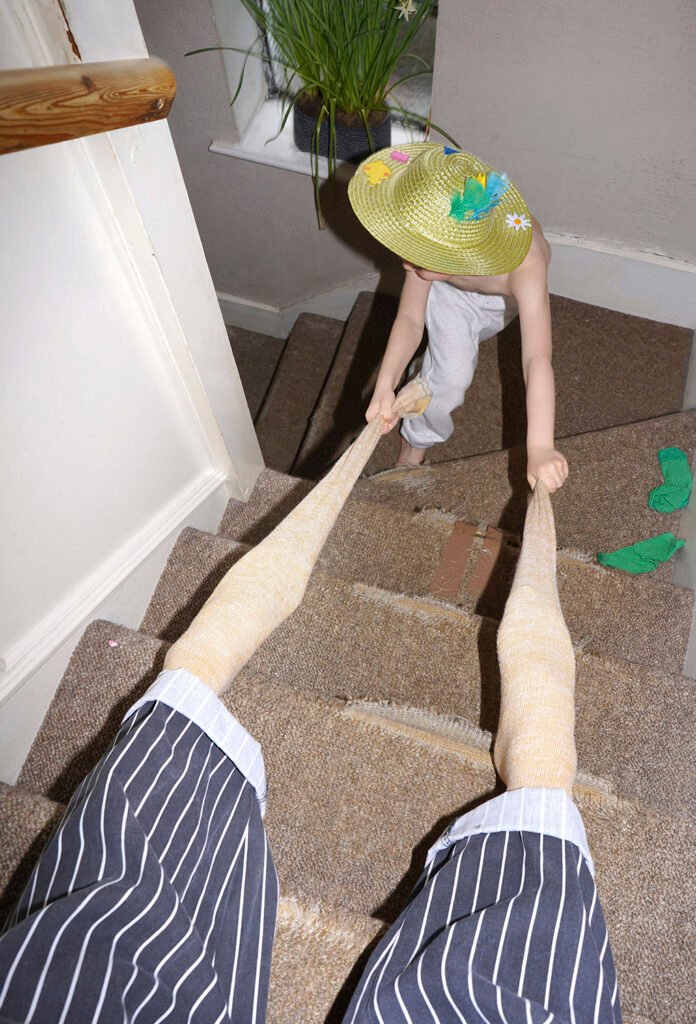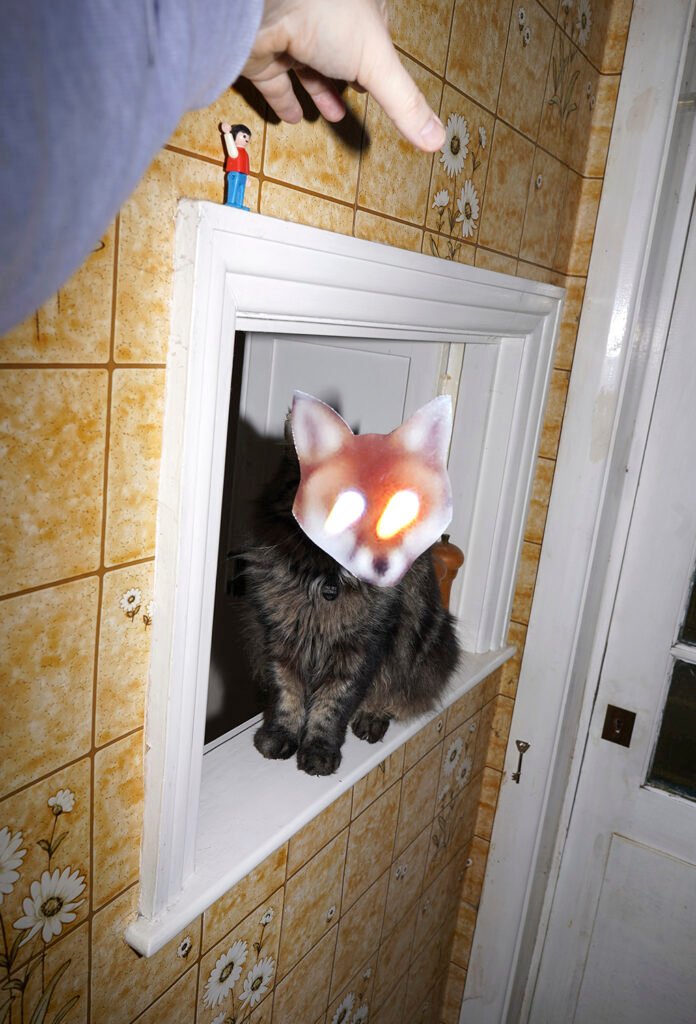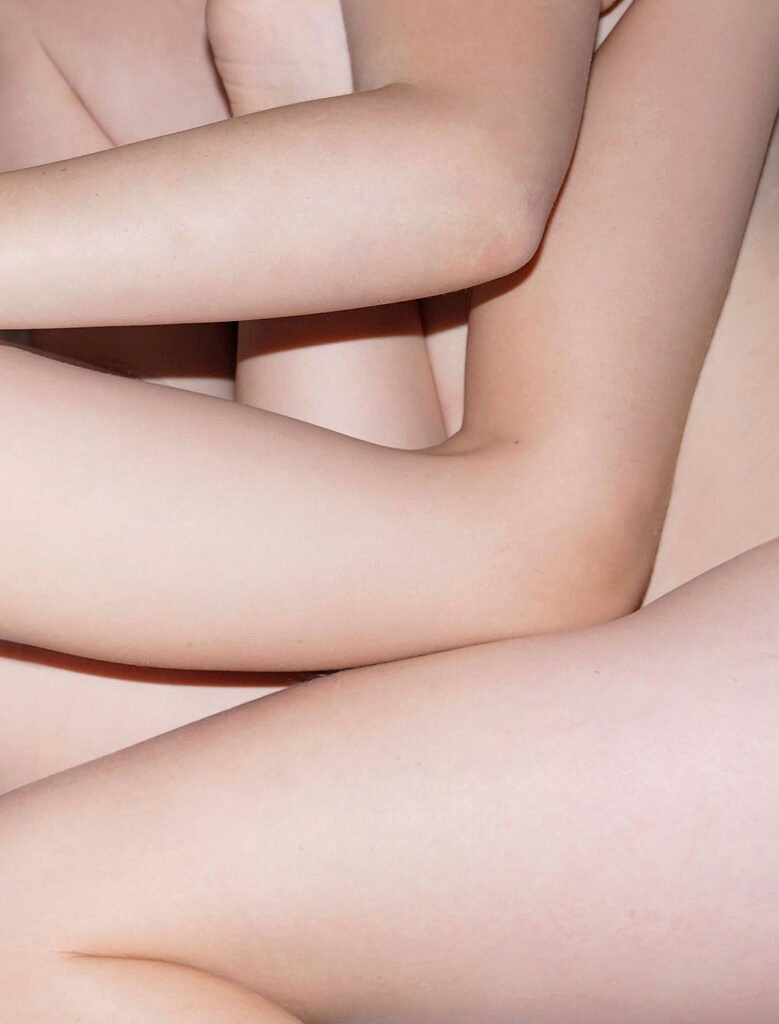‘Firstly, I try to stress the importance of home and the family: I feel they are terribly important.
And secondly, I try to stress the fact that the theory of gravity is a lot of nonsense.’Ivor Cutler, 1959
I first discovered Guy Bolongaro’s photographs in 2019. I believe that a friend sent me his profile on Instagram, and I suddenly started to follow it for its playful, tender, and surreal energy. As for every other photographic project that attracts us—and I say “we” because I imagine not to be the only fan-person here—I remember the desire to physically leaf through these images. So I checked the links, but no publication yet. As peeking through the eyelet of a door, I kept on occasionally observing the glimpses of this family and its surroundings, sometimes slipping on an enchanted parallel world, other times finding a less fairy and more unsettling one.
Bolongaro studied sociology before moving to London to become a social worker. He began taking pictures around 2014 as a form of ‘daily art therapy,’ in particular on his lunch breaks, and walks home from work. After the birth of his first child, he shifted focus from the public sphere to his domestic routines, exploring ambivalent feelings on how we live within the idealized family unit. In Bolongaro’s microcosm—timeless and apparently exempt from gravity—there are eggs and lit candles that levitate, flying children, mirrorings and doublings, collage-like overlappings, demonic foxes, a Cheshire-like cat, alongside quieter scenes of hair being brushed, laundry being folded, and makeup rituals.
At the end of last year, when I learned that Here Press published Bolongaro’s project under the title of Gravity Begins At Home, I contacted Guy to ask for a chat on his work, and he kindly accepted. We ended up touching on alternative households, the kids’ genius, aesthetical non-representation, Ronald Laing’s book “Conversations with Adam and Natasha,” and much more.
Guy Bolongaro: The heart of this book is: “my family is ok. It can work. Yes, it works. Oh look, it actually works, and it is beautiful!” But I have been thinking a lot about alternatives to the family. The classic bourgeois family unit does not work. It is empirically very weak but as an idea it very strong. We should look for an alternative household model, but our political and economic constraints won’t allow this. We need to reconfigure the family, you know, find another way to share child care and child rearing within kinship or friendship groups. I have the privilege which affords the condition where the ‘nuclear’ family can just about work, but most do not have the conditions for this model to function. This book is sort of my reinforcing to myself that it can work for us and that is not something I take for granted. You catch the joyful moments more than the difficult ones maybe because as a father I need to participate without the camera when things get tough! My ambivalence about the family model is not necessarily represented in the images although certainly there is some ambiguity there.
Matilde Manicardi: There are very few examples of units that work outside the family that we are used to conceiving. With a lack of models, it becomes even tougher to try something different.
GB: This is the thing. You cannot try to revisit the ideas of the seventies, and you certainly cannot go back to a more extended network of families because it belongs to a pre-industrial era, we are displaced now and live differently. Everything has to go beyond transaction, but our personalities are still ingrained and saturated with capitalist relations. So, we want to live differently, but the economic, social, and political environment conditions us. I don’t know what the answer is, we have to go through this period of domestic realism, this unquestioning acceptance of the family to something else better suited to our purposes.
MM: I am curious to know what your kids thought of the book.
GB: Yes, it’s interesting. What they think of it now, and what they will think of it in the future. I have been pondering a lot about their future relationship with it. Rudy is nine, and I asked her permission as much as possible on which images she wanted, and a couple of times she said no. There was a process of negotiation with them. But they like the pictures… sometimes I have to describe what there is in there, in the most surreal ones, and they are like: “no, this is not good, is rubbish, why would you take a picture in which you cannot even see anything?”
but for the actual process, as long as I didn’t push too much, they were really into it. And there is a fine line between having fun and having to do it. As soon as they sense the shift between “this is fun,” and “now you want something,” they are just done. If I thought: “oh this is working, this is a nice energy, let me just change something,” as soon as I got to change something, it’s over. You cannot manipulate children in that way.
MM: And this is great because you can see when there is no manipulation there.
GB: Yeah. There were a few times where I got an idea, I tried to set it up, and of course, it immediately turned out flat. No energy. Just nothing. No dynamic at all. And the children are pissed off because they don’t want to be told what to do. You learn to let them lead. And the best things always happen when children lead. Always. Lack of self-consciousness, lack of boundaries in terms of imagination.
They seem to love the book. They haven’t taken that much interest in sitting there and looking at it, but that will happen over time; we have a few copies around the house. But they love putting on stickers. There are stickers all over our home now. In some ways, the stickers were their idea. They wanted to have the cut-out on the book, and we (Ben at HERE and I ) thought: “let’s take that one step forward. Let’s make it more interactive.”
MM: Gravity Begins at Home reminds me of the 1977 publication “Conversations with Adam and Natasha” by psychiatrist Ronald D. Laing. In this book, that I honestly recommend to anyone, he collected the most absurd and vivid exchanges of words with his two kids, and between them, without any filter. And he did it mainly to observe them and get to know them more.
GB: I remember, a long time ago, I went for a period being interested in Laing. Mainly it was when I was using anti-depressants myself, and I was feeling very resistant to the psychiatric model. But at the time, I didn’t have children, so I wasn’t as interested as I would be now. At the age where his children were—I think that Adam was six or seven and his daughter was a little younger—that is the age just before embarrassment comes in child development, whether or not it’s a developmental thing, it has to do with the environment, or people in school giving you social pressure. But before that age, it is so fascinating to hear the internal dialogue/monologue. When I sit down and observe my kids, the funniest, most surreal stuff happens, it’s completely unfiltered by external influence, and it’s the most beautiful part of childhood. At five years old, it’s the first year of school, there is no self-consciousness at all, and they sponge everything. I remember, when Ivor turned five, thinking: “that is the perfect human, the perfect age to be, a perfect prism for light and joy and fun.” Now sentimental dad is taking over!
MM: I read that you started using photography as a form of “daily art therapy.” In what ways do you think that producing and consuming images can serve as a healing process?
GB: I was working as a social worker, and I was in a bad period with my health. At that time, I was making documentary films. It was just so much work that takes forever to do. I was not living well and just eroding all of my defenses and getting very ill. Then I started to pick up a camera, and I just got “uh, that is a picture, done!” finished. It feels so satisfying to walk around, just responding to the pure enjoyment of looking. That process gave me something to look forward to every day, and I got excited at the point in which it became a complete compulsion, but a therapeutic one.
W. H. Auden once wrote that art was not a means by which an artist necessarily communicates or arouses feelings in others, but a mirror in which the artist and audience become conscious of what their own feelings really are. He saw the proper effect of art as disenchanting, ridding you of your illusions. This echoes what Freud intended the role of the psychoanalyst to be, to not deliberately arouse or communicate feelings but to act as a mirror in which patients would become conscious of what their own feelings really are. That is a good model for art therapy, showing back to yourself the patterns you are running, the patterns in your aesthetic choices.
MM: I remember that I discovered your Instagram profile in 2019, and, since then, I took the habit of coming back to it once in a while to look for new shots. This makes me think that the gratification is not only for the artist but also for who waits for the images that the artist will produce next.
GB: I was inspired by a photographer called Jason Evens. He was a famous fashion photographer in the 90s, but then he got a bit disillusioned I think, he moved to the coast, and started a website called The Daily Nice. Every day he would post one photo on it, and, at the end of the day, he would take it off. It could be a mushroom, an abstract, a portrait of a friend; every day, just the pure pleasure of looking, combined with his beautiful way of framing the world. And this is what inspired me to do it. Still today, ten years later, I look forward every day to seeing what he is going to post.
MM: And what do you appreciate about your pictures as a viewer?
GB: No one asked me that before. I have quite an ambivalent relationship with my work. Having this book physically in my hands now makes me notice what other people appreciate. I can see the fun, the fresh or original approach, maybe because I am not a trained photographer, or because I picked it up very late in my life. There is a sense of playfulness and humor, which is very important to me in life. And then definitely the surreal, and the weird. Coming from a painting background, I do have a sense of the image, but it can be limiting because sometimes I fall into two-dimensionality. I also think I have good timing, a sense of where the energy is.
MM: Did your knowledge and experience as a social worker influence your approach to photography?
GB: When I started taking photographs in the public sphere , I was already confident with people. I did not feel barriers with strangers at all. And I wouldn’t have had that at 21, without having been a social worker. On a good day, I have empathy toward people and a lot of compassion. And that’s a really good thing to have as a photographer out in the public—to be able to not see a barrier and always to see people’s dignity is a good thing to have learned. And you don’t need to study art to do so. You can acquire it by studying philosophy, sociology, or whatever.
MM: This project is shot in intimate places and narrates intimate moments. Yet, subjects are often not recognizable, which makes them almost dreamlike figures—as they represented just a figment of your imagination. Why do you think you did this?
GB: The simple answer is that it is a challenge. In how many interesting ways can you obscure a figure? But, if you talk to a psychoanalyst, they would say this is not the correct answer. There is no coincidence. In your aesthetic choices, everything has to do with your unconscious life. So, I started looking into it, and then I came across a paper by Levine on the aesthetical non-representation. Trying to give a basic interpretation of his research, it happens when you find it very hard to connect to people, and you had a relationship with your parents in which they didn’t give you enough emotional mirroring, so you try to create it. Not seeing it, you can either start to hallucinate it, and this leads to psychosis, or you start to re-present it to yourself. And this reveals the artist’s sensibility: what is not there, or very weakly inscribed. And in re-presenting it, you might lack the ability to realize this image, but you keep trying, and trying. Anyway I recommend the paper. I’m getting better at not always approaching the portrait obliquely. There are a couple of portraits in the book of my daughter Rudy, where I truly think I got it. But there are very few that make me think: “ok, that’s her.”
MM: And these portraits stand out. There are very few eyes looking at you leafing through, and when you see them, it’s impactful. It’s enough to create the connection with the subject, and then, when you go on with the other pictures, you remember the expression, and you cherish that glimpse of intimacy.
GB: This was also my feeling in the edit. And it was the same with the portraits of my wife. I wanted to have her at the center of the book because she is the force that holds everything together, but I was struggling to photograph her still. Maybe in the future, I will get better at photographing her, but, at present, I find it hard. Still, you can feel her presence and how she makes things function. She’s always there participating and facilitating with grace and love.
Guy Bolongaro (born Crewe, 1978) studied sociology before moving to London to become a social worker. Around 2014, burnt out by work and frustrated by his attempts at making documentary films in his spare time, he began taking photographs as a form of ‘daily art therapy,’ making images on his lunch breaks and walks home from work. A few years after the birth of his first child he shifted focus from the public sphere to the family cosmos, turning attention from his walking routes to his domestic routines. Gravity Begins at Home is the culmination of his photography in that period. His commercial and editorial work has appeared in The Guardian, I-D, NOON, American Chordata, GQ, The Wire, Vice, Wul, C41, Creative Review, Elephant and others.
